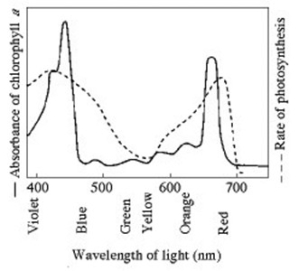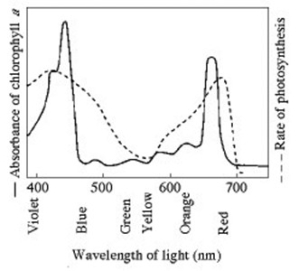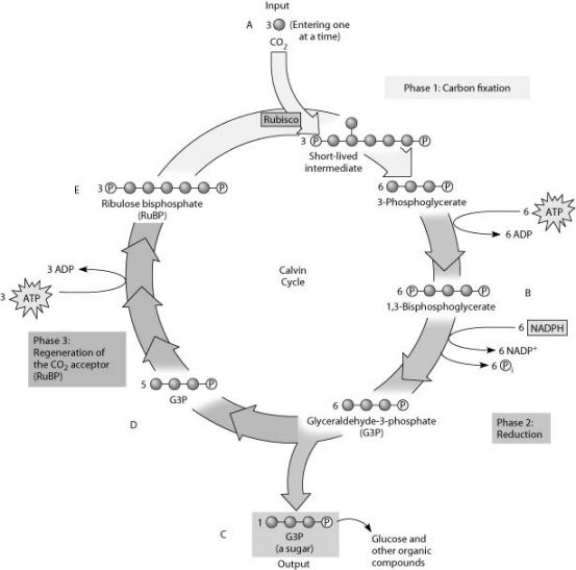A) reduction of NADPH
B) release of oxygen
C) regeneration of the CO₂ acceptor
D) production of ATP
F) A) and B)
Correct Answer

verified
Correct Answer
verified
Multiple Choice
In a plant, which of the following reactions produce molecular oxygen (O₂) ?
A) the light reactions alone
B) the Calvin cycle alone
C) the light reactions and the Calvin cycle
D) neither the light reactions nor the Calvin cycle
F) All of the above
Correct Answer

verified
Correct Answer
verified
Multiple Choice
What are the products of linear electron flow during the light reactions of photosynthesis?
A) heat and fluorescence
B) ATP and P700
C) ATP and NADPH
D) ADP and NADP⁺
F) All of the above
Correct Answer

verified
Correct Answer
verified
Multiple Choice
CAM plants keep stomata closed in the daytime, thus reducing loss of water. They can do this because they ________.
A) fix CO₂ into organic acids during the night
B) fix CO₂ into sugars in the bundle-sheath cells
C) fix CO₂ into pyruvate in the mesophyll cells
D) use photosystem I and photosystem II at night
F) All of the above
Correct Answer

verified
Correct Answer
verified
Multiple Choice
Use the following figure to answer the question.
 What wavelength of light in the figure is most effective in driving photosynthesis?
What wavelength of light in the figure is most effective in driving photosynthesis?
A) 420 nm
B) 575 nm
C) 625 nm
D) 730 nm
F) All of the above
Correct Answer

verified
Correct Answer
verified
Multiple Choice
In the initial step in carbon fixation, a molecule of CO₂ is attached to RuBP to produce a six-carbon molecule, which is immediately split to produce two molecules of 3-phosphoglycerate. After phosphorylation and reduction produces glyceraldehyde 3-phosphate (G3P) , what more needs to occur to complete the Calvin cycle?
A) addition of a pair of electrons from NADPH
B) regeneration of ATP from ADP
C) regeneration of RuBP
D) regeneration of NADP⁺
F) A) and B)
Correct Answer

verified
Correct Answer
verified
Multiple Choice
In which of the following organisms did the process of photosynthesis most likely originate?
A) in plants
B) in prokaryotes
C) in fungi
D) three separate times during evolution
F) A) and C)
Correct Answer

verified
Correct Answer
verified
Multiple Choice
Which of the following processes is most directly driven by light energy?
A) creation of a pH gradient by pumping protons across the thylakoid membrane
B) carbon fixation in the stroma
C) reduction of NADP⁺ molecules
D) removal of electrons from chlorophyll molecules
F) A) and D)
Correct Answer

verified
Correct Answer
verified
Multiple Choice
Which process is most directly driven by light energy?
A) creation of a pH gradient by pumping protons across the thylakoid membrane
B) reduction of NADP⁺ molecules
C) transfer of energy from pigment molecule to pigment molecule
D) ATP synthesis
F) A) and C)
Correct Answer

verified
Correct Answer
verified
Multiple Choice
What is the relationship between the wavelength of light and the quantity of energy per photon?
A) They have a direct, linear relationship.
B) They are inversely related.
C) They are logarithmically related.
D) They are separate phenomena.
F) None of the above
Correct Answer

verified
Correct Answer
verified
Multiple Choice
Use the following figure to answer the question.
 The figure shows the absorption spectrum for chlorophyll a and the action spectrum for photosynthesis. Why are they different?
The figure shows the absorption spectrum for chlorophyll a and the action spectrum for photosynthesis. Why are they different?
A) Green and yellow wavelengths inhibit the absorption of red and blue wavelengths.
B) Oxygen given off during photosynthesis interferes with the absorption of light.
C) Other pigments absorb light in addition to chlorophyll a.
D) Aerobic bacteria take up oxygen, which changes the measurement of the rate of photosynthesis.
F) None of the above
Correct Answer

verified
Correct Answer
verified
Multiple Choice
Paper chromatography is a technique used to separate molecules based upon their size and solubility in a particular solvent. If pigments from a particular species of plant are extracted and subjected to paper chromatography, which of the following results is most likely?
A) Paper chromatography would produce a single band of pigment that is characteristic of that particular plant.
B) Paper chromatography would separate the pigments into two bands that appear green.
C) Paper chromatography would separate the pigments into several bands that appear green or yellow/orange.
D) Paper chromatography would separate the pigments into two bands, one that appears blue and one that appears red.
F) All of the above
Correct Answer

verified
Correct Answer
verified
Multiple Choice
What would be a likely consequence of a mutation in plants that results in a photorespiration deficiency?
A) Photosynthetic efficiency would be reduced at low light intensities.
B) Cells would carry on the Calvin cycle at a much slower rate.
C) There would be more cellular damage from harmful products of the light reactions of photosynthesis.
D) Less oxygen would be produced by photosynthesis.
F) C) and D)
Correct Answer

verified
Correct Answer
verified
Multiple Choice
Students conducted an experiment to determine the effect of light intensity on the rate of photosynthesis. They punched 40 leaf disks from spinach leaves and used a syringe partially filled with water to pull the gases from the leaf disks so that all leaf disks sunk to the bottom of the syringe. Ten leaf disks from the syringe were placed in each of four cups and covered with 50 ml of the solutions as indicated below. All leaf disks were resting on the bottom of the cups when the experiment began. The volume of liquid in each cup and the temperature of the solutions were held constant. All cups were placed 0.5 meters from the designated light source. A large beaker of water was placed between the light and the cups to act as a heat sink to prevent a change in temperature. At the end of 10 minutes, the number of disks floating in each cup was recorded. Use your knowledge of the mechanism of photosynthesis and the data presented in the chart to determine which of the statements is a correct explanation for the students' data.
A) Cup 1 had a low rate of photosynthesis because 0.5 grams of baking soda did not provide a sufficient amount of CO₂.
B) Cup 2 had the highest rate of photosynthesis because it had the highest ratio of disks floating to wattage of light.
C) Cup 3 had the same rate of photosynthesis as Cup 1 because they had the same ratio of disks floating to wattage of light.
D) Cup 4 had the lowest rate of photosynthesis because it had the least CO₂.
F) C) and D)
Correct Answer

verified
Correct Answer
verified
Multiple Choice
Use the following figure to answer the question.
 Refer to the accompanying figure and the molecules labeled A, B, C, D, and E. If the carbon atom of each of the incoming CO₂ molecules is labeled with a radioactive isotope of carbon, which organic molecules will be radioactively labeled after one cycle?
Refer to the accompanying figure and the molecules labeled A, B, C, D, and E. If the carbon atom of each of the incoming CO₂ molecules is labeled with a radioactive isotope of carbon, which organic molecules will be radioactively labeled after one cycle?
A) C only
B) B, C, D, and E
C) C, D, and E only
D) B and C only
F) B) and C)
Correct Answer

verified
Correct Answer
verified
Multiple Choice
Why are C₄ plants able to photosynthesize with no apparent photorespiration?
A) They do not participate in the Calvin cycle.
B) They use PEP carboxylase to initially fix CO₂.
C) They conserve water more efficiently.
D) They exclude oxygen from their tissues.
F) A) and B)
Correct Answer

verified
Correct Answer
verified
Multiple Choice
Carbon dioxide is split to form oxygen gas and carbon compounds in which of the following metabolic pathways?
A) only photosynthesis
B) only respiration
C) photosynthesis and respiration
D) neither photosynthesis nor respiration
F) B) and D)
Correct Answer

verified
Correct Answer
verified
Multiple Choice
A spaceship is designed to support animal life for a multiyear voyage to the outer planets of the solar system. Plants will be grown to provide oxygen and to recycle carbon dioxide. Since the spaceship will be too far from the sun for photosynthesis, an artificial light source will be needed. What wavelengths of light should be used to maximize plant growth with a minimum of energy expenditure?
A) full-spectrum white light
B) green light
C) a mixture of blue and red light
D) UV light
F) B) and D)
Correct Answer

verified
Correct Answer
verified
Multiple Choice
Where are ATP synthase complexes located in plant cells?
A) thylakoid membrane only
B) inner mitochondrial membrane only
C) thylakoid membrane and inner mitochondrial membrane
D) thylakoid membrane and plasma membrane
F) A) and C)
Correct Answer

verified
Correct Answer
verified
Multiple Choice
Which of the following statements correctly describes a distinction between autotrophs and heterotrophs?
A) Cellular respiration is unique to heterotrophs.
B) Only heterotrophs have mitochondria.
C) Autotrophs, but not heterotrophs, can nourish themselves beginning with CO₂ and other nutrients that are inorganic.
D) Only heterotrophs require oxygen.
F) C) and D)
Correct Answer

verified
Correct Answer
verified
Showing 41 - 60 of 65
Related Exams